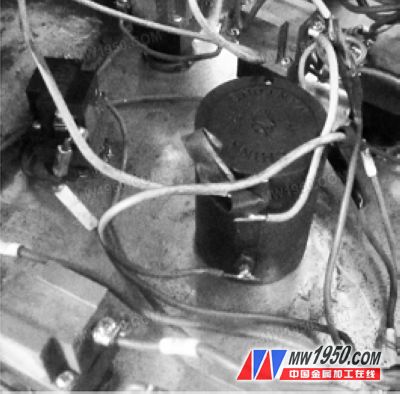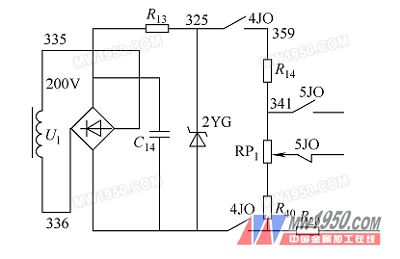3. Function realization
The black cylinder in Figure 3 is a multi-turn potentiometer. Figure 4 shows the modified given circuit. RP1 is a multi-turn potentiometer. The signal preamplifier in the original circuit is not changed, so it is omitted in Figure 4. go with. The multi-stage changeover switch TS in Fig. 1 is replaced by the multi-turn potentiometer RP1. After this modification, the given control is changed from the original stepped control to the current stepless speed regulation. When it is necessary to adjust the timing, the rotation is multi-turn. The rotating shaft of the potentiometer can easily and smoothly adjust the magnitude of the given voltage, and is added to the emitter junction of the amplifier 5BG after comparison with the negative feedback of the tachometer and the voltage and current differential negative feedback. This adjustment can make the output DC after the amplifier is turned on. The control voltage is more stable and reliable, and the speed regulation process is smoother.

Figure 3 multi-turn potentiometer

Figure 4 modified circuit given
4. Transformation effect
The original multi-stage transfer switch is bulky, and the resistors of all stages are soldered on the circuit board. After a long time, the phenomenon of desoldering and soldering is prone to occur. The long-term closing and closing of the moving and static contacts is easy to wear and contact. When there is a given voltage, it sometimes does not increase the workload of maintenance. The multi-turn potentiometer has small volume, convenient installation, high linear precision, small resistance error and convenient maintenance.
5 Conclusion
After more than one year of use, the multi-turn potentiometers are in good condition, the speed regulation process is smooth and reliable, the processing quality is very stable, and the company recovers hundreds of thousands of yuan in economic losses every month.
| Previous page | 1 | 2 | Next page |
Set screw is also called head screw and positioning screw. The utility model is a screw specially used for fixing the relative position of machine parts. Type: square flange end set Bolt, GB / t821-1988 square chamfered end set screw, GB / t85-1988 square long cylindrical end set screw, inner square head set screw, etc.
Related categories
Hexagon socket set screw, hexagon flat set screw, hexagon cylindrical set screw.
The selection of common set Screws is generally used to fix the relative position of two parts with little force. The axial and circumferential positioning of common sleeve like parts on the shaft. There are many kinds of set screws. The common ones are as follows: according to the end part, there are conical end, flat end, concave end, oblong cylinder head, etc;
According to the head part: slotted, hexagon socket, square head, etc. Tapered end screws and concave end screws with sharp ends can be used to directly top the parts, and the concave end is more reliable and can bear greater force; Taper end screws without sharp points must be drilled in the parts. The flat end is used to top the tight plane, which does not damage the parts, but bears limited load.
Slotted screws have small tightening force and are often easy to screw off. Generally, they prefer hexagon socket head; The tightening force of square head is the largest, but it can not be embedded in parts, and its use is limited. In order to prevent loosening and withdrawal of threaded parts, a set screw can be drilled at the cross seam. The long cylindrical head screw at the top end is used in the keyway of the shaft to lock and prevent circumferential rotation. It can also be used in general unimportant occasions when the key slides in the keyway of the shaft.
Set Screws,Allen Nose Set Screw,Slotted Head Set Screw,Hexagon Socket Grub Screw
Suzhou Gubao Screws Co.,Ltd. , https://www.gbscrewes.com